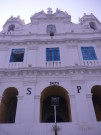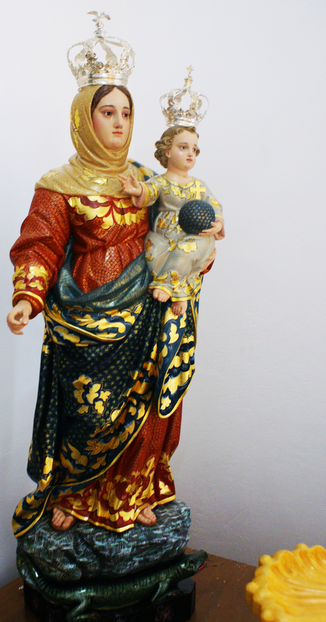
Our Lady of Penha de Franca

Our Lady of Penha de Franca gets its name due to its location on a “penha” or peak by the sea. The name of the church comes from Penha de França a Portuguese parish (freguesia) in the municipality of Lisbon. It was created on April 13, 1918.
Our Lady of the Rock of Franca or Our Lady of the Rock is one of the names that is given to Mary, mother of Jesus. It is believed Our Lady of Penha de Franca appeared to Simon Vela in western Spain, in a mountain range called Penha de Franca. The feast of Our Lady of Penha da Franca is celebrated on 8 September. The feast of Penha de Franca is considered by the Catholic Church as the third largest religious festival in Brazil, behind only the celebration that honors the patron saint of Brazil, in Aparecida, Sao Paulo, and the Cirio de Nazaré, in Belém,
In western Spain there is a very high and steep mountain called Penha de France, in the province of Salamanca.
Around 1434, according to some historical sources on 19 May, some French pilgrims dreamed of a statue of Our Lady which was supposedly buried on top of steep mountain, because of a war between Christians and Muslims, in which Catholics hid their images not be destroyed. Simon Vela was the pilgrim who had the vision of Our Lady surrounded by light beckoning him to go look for her. Simon Vela spent five years been looking for the aforementioned mountains, until one day he found the mount just as he had dreamt. After three days of intense walk, the reason for his motivation according to him was Our Lady’s call to him saying, “Simon, do not sleep!”. Simon climbed the steep rocks after which the monk stopped to rest when he saw sitting next to him a beautiful lady with the child in her arms. She indicated to him the place where he would find what he sought. Aided by some pastors in the region, he managed to find the image that he had seen in a dream.
Simon Vela built a rough hermitage there, which soon became famous for many miracles obtained through the Lady of Penha de Franca, and later there was built a shrine at the top of Penha de France, in the city of El Cabaco ( Salamanca, Spain). The French Catholic intellectual Maurice Legendre influenced the recovery of the sanctuary (specifically, in 1934 organized a pilgrimage to mark the fifth centenary of the discovery of the image). Legendre is buried in the nave of the church.
The Common image of Penha de Franca originated from a horseback traveler, attacked by a snake and saved by an alligator (Brazilian version of the Lizard). At the top of the Aligator is seen Our Lady of the Rock with the Child Jesus in her left arm and right hand extended holding sometimes a scepter. This representation of the Virgin Mary is often in paintings, sculptures because only show Mary with Child in her arms.
A while after the famous battle of Alcazarquivir, a plague struck Portugal and Spain. Both the countries managed to get rid of the scourge due to the intervention of Our Lady of Penha de Franca, the Senate of the Lisbon Chamber promised Our Lady of Penha de Franca they would build a grand church, if she rid the city of the disease. Almost miraculously the epidemic vanished, the Senate then built a magnificent church there.
This Our Lady of Penha de Franca Church has attracted thousands of pilgrims and at one time a devotee, having climbed to the top of the mountovercome by fatigue fell asleep. A large snake came and was about to bite him when a huge lizard jumped over him waking him in time to kill the snake with his staff. That is why the image of Our Lady of Penha de Franca has a pilgrim, the snake and lizard.